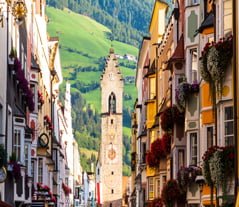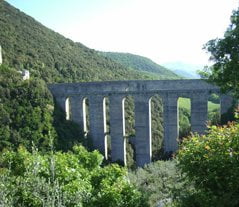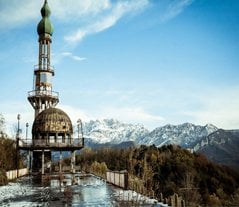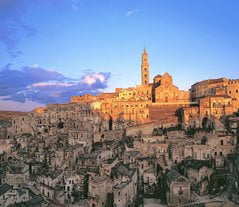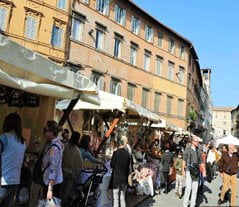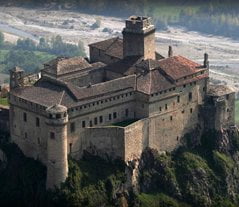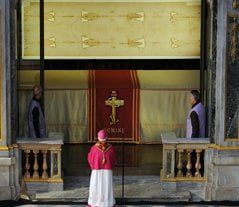 If the main purpose of your ideal honeymoon is to enjoy some peaceful relaxation with your new spouse, Sicily may be your perfect destination. Sicilians are famous for living life at a slower pace compared to the rest of Italy and how can they not when their home is full of picturesque landscapes, stunning beaches, and spectacular food? Sicily’s larger cities such as Palermo and Catania are full of history and offer great opportunities for sightseeing, while smaller seaside towns like Taormina and Cefalù attract visitors from all over the world thanks to their pristine beaches and simple charm. Continue reading "Sicily Adds Old World Romance to Honeymoon"
If the main purpose of your ideal honeymoon is to enjoy some peaceful relaxation with your new spouse, Sicily may be your perfect destination. Sicilians are famous for living life at a slower pace compared to the rest of Italy and how can they not when their home is full of picturesque landscapes, stunning beaches, and spectacular food? Sicily’s larger cities such as Palermo and Catania are full of history and offer great opportunities for sightseeing, while smaller seaside towns like Taormina and Cefalù attract visitors from all over the world thanks to their pristine beaches and simple charm. Continue reading "Sicily Adds Old World Romance to Honeymoon"
Newsletters
3 Italian Seaside Destinations for Your Honeymoon
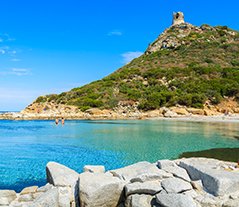 If the beauty of Italy’s coasts has caught your attention, but you aren’t sure where to start, here are three stunning destinations to consider when planning your upcoming honeymoon: Continue reading "3 Italian Seaside Destinations for Your Honeymoon"
If the beauty of Italy’s coasts has caught your attention, but you aren’t sure where to start, here are three stunning destinations to consider when planning your upcoming honeymoon: Continue reading "3 Italian Seaside Destinations for Your Honeymoon"
Ponte delle Torri – A bridge between two fortresses
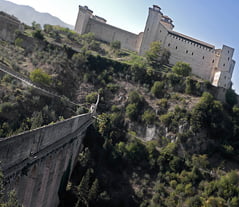 In a large gorge south of Spoleto, an imposing limestone bridge arises from a sea of lush vegetation. The precise, man-made structure juxtaposes with the wild, organic flora that surrounds it to create a breathtaking panorama unforgettable to those who have the chance to admire it. Spoleto’s Ponte delle Torri (Bridge of Towers) is not only the most iconic symbol of the city, but for centuries it has been an inspiration to countless poets and artists (from famed German writer Johann Goethe to British landscape painter J.M.W. Turner, and many more).
In a large gorge south of Spoleto, an imposing limestone bridge arises from a sea of lush vegetation. The precise, man-made structure juxtaposes with the wild, organic flora that surrounds it to create a breathtaking panorama unforgettable to those who have the chance to admire it. Spoleto’s Ponte delle Torri (Bridge of Towers) is not only the most iconic symbol of the city, but for centuries it has been an inspiration to countless poets and artists (from famed German writer Johann Goethe to British landscape painter J.M.W. Turner, and many more).
Continue reading "Ponte delle Torri – A bridge between two fortresses"
Gluten-Free food in Italy: a new path to Italian flavors
Italy , a land whose cuisine is known world-wide thanks to gluten-rich staples such as pasta and pizza, is actually quite celiac disease friendly. Nearly one percent of Italians test positive for celiac disease, which is an intolerance for gluten, a protein found in wheat. This percentage is on par with the global average, so the increase of gluten-free options is not driven by a higher affected population in the nation. Rather it is actually wheat’s pervasiveness in Italian cuisine that has increased public awareness of the disease and has spurred the growth of the gluten-free market in the southern European peninsula. In fact, currently there are roughly 4,000 restaurants in Italy that offer senza glutine (gluten-free) options, and the number of cities throughout the country without a gluten-free restaurant is sharply decreasing.
, a land whose cuisine is known world-wide thanks to gluten-rich staples such as pasta and pizza, is actually quite celiac disease friendly. Nearly one percent of Italians test positive for celiac disease, which is an intolerance for gluten, a protein found in wheat. This percentage is on par with the global average, so the increase of gluten-free options is not driven by a higher affected population in the nation. Rather it is actually wheat’s pervasiveness in Italian cuisine that has increased public awareness of the disease and has spurred the growth of the gluten-free market in the southern European peninsula. In fact, currently there are roughly 4,000 restaurants in Italy that offer senza glutine (gluten-free) options, and the number of cities throughout the country without a gluten-free restaurant is sharply decreasing.
Continue reading "Gluten-Free food in Italy: a new path to Italian flavors"
Consonno: an Abandoned City of Toys
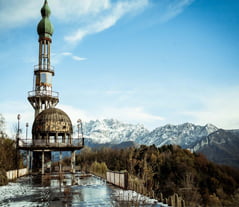 For most of its history, Consonno, located in the hills of Brianza, in the Lombardy region, was an agricultural town with a population that never surpassed 300 inhabitants. The town has its origins in the Middle Ages, but thanks to its remote location and only one road leading to the town’s entrance, Consonno never truly thrived. Despite this, an eccentric magnate named Count Mario Bagno saw a unique opportunity in this meek village.
For most of its history, Consonno, located in the hills of Brianza, in the Lombardy region, was an agricultural town with a population that never surpassed 300 inhabitants. The town has its origins in the Middle Ages, but thanks to its remote location and only one road leading to the town’s entrance, Consonno never truly thrived. Despite this, an eccentric magnate named Count Mario Bagno saw a unique opportunity in this meek village.
Matera: European Capital of Culture 2019
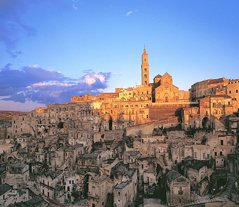 The European Capital of Culture is a title given to a European city for an interval of one year during which the city will organize cultural events showcasing both the city and its role in Europe. Established in 1985, this distinction aims to promote European unity. The title is an opportunity for European cities to gain international attention as well as obtain possible economic and social benefits. For the year 2019, an international panel of cultural experts have chosen the proposals of Matera, Italy and Plovdiv, Bulgaria. Several cities in Italy have been awarded this distinction before (such as Florence, Bologna, and Genoa) but this is the first time a city in southern Italy has been chosen by the panel, and the honor is long overdue.
The European Capital of Culture is a title given to a European city for an interval of one year during which the city will organize cultural events showcasing both the city and its role in Europe. Established in 1985, this distinction aims to promote European unity. The title is an opportunity for European cities to gain international attention as well as obtain possible economic and social benefits. For the year 2019, an international panel of cultural experts have chosen the proposals of Matera, Italy and Plovdiv, Bulgaria. Several cities in Italy have been awarded this distinction before (such as Florence, Bologna, and Genoa) but this is the first time a city in southern Italy has been chosen by the panel, and the honor is long overdue.
Perugia’s Fair of the Dead
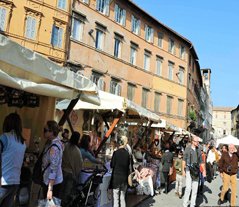 In the Italian region of Umbria, fairs are common events and they have a rich history that dates back to medieval times. The earliest fairs in this area were celebrations of Ognisanti (All Saints Day) at the beginning of November. These fairs developed into bustling markets that allowed commerce between medieval towns to flourish, and they also provided the opportunity for people to gather provisions for the winter. In modern times, these markets have greatly expanded, but much of the original spirit remains.
In the Italian region of Umbria, fairs are common events and they have a rich history that dates back to medieval times. The earliest fairs in this area were celebrations of Ognisanti (All Saints Day) at the beginning of November. These fairs developed into bustling markets that allowed commerce between medieval towns to flourish, and they also provided the opportunity for people to gather provisions for the winter. In modern times, these markets have greatly expanded, but much of the original spirit remains.
The Ancient Chocolate of Modica
The south-easter n Sicilian city of Modica is a UNESCO World Heritage Site known for its stunning Baroque architecture. Along with seven other towns in the Val di Noto, like Ragusa and Catania, Modica was rebuilt in 1693 following a powerful earthquake that devastated the area. The construction after the earthquake resulted in remarkable city planning and the culmination of Baroque style of art and architecture in Europe. Though Modica is stunning and filled with beautiful architecture, this city tucked away in the Hyblaean Mountains is also internationally famous for a much sweeter reason: chocolate.
n Sicilian city of Modica is a UNESCO World Heritage Site known for its stunning Baroque architecture. Along with seven other towns in the Val di Noto, like Ragusa and Catania, Modica was rebuilt in 1693 following a powerful earthquake that devastated the area. The construction after the earthquake resulted in remarkable city planning and the culmination of Baroque style of art and architecture in Europe. Though Modica is stunning and filled with beautiful architecture, this city tucked away in the Hyblaean Mountains is also internationally famous for a much sweeter reason: chocolate.
The Charming Hills of Piacenza
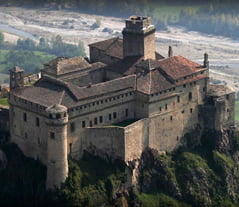 When most tourists plan their itinerary around Italy, they think about the usual cities, such as Rome, Venice, Milan and Bologna, among so many others. There are smaller destinations along the way that will truly give you an untouched and authentic feeling of what Italian culture and history is all about. Continue reading "The Charming Hills of Piacenza"
When most tourists plan their itinerary around Italy, they think about the usual cities, such as Rome, Venice, Milan and Bologna, among so many others. There are smaller destinations along the way that will truly give you an untouched and authentic feeling of what Italian culture and history is all about. Continue reading "The Charming Hills of Piacenza"
An Extraordinary Pilgrimage to the Shroud of Turin
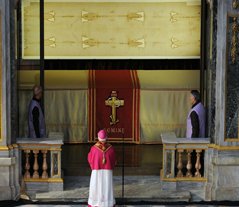 The Shroud of Turin is perhaps one of the most mystical images of all time. It was said to have been the cloth that covered Jesus of Nazareth upon his burial. First noticed in 1898 by a photographer who was shooting pictures of it, it clearly depicts an image of the crucifixion. Due to its delicate nature, it is only displayed publicly a few times during the curse of the century.
The Shroud of Turin is perhaps one of the most mystical images of all time. It was said to have been the cloth that covered Jesus of Nazareth upon his burial. First noticed in 1898 by a photographer who was shooting pictures of it, it clearly depicts an image of the crucifixion. Due to its delicate nature, it is only displayed publicly a few times during the curse of the century.
Continue reading "An Extraordinary Pilgrimage to the Shroud of Turin"

